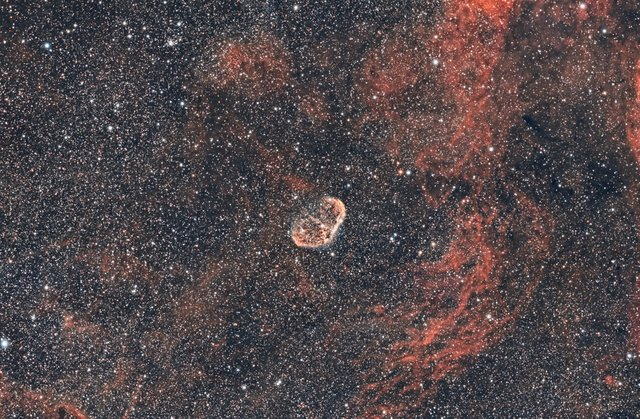Curating the Internet: Science and technology micro-summaries for September 25, 2019
Boston Dynamics' robot dog now available to order; New technique for learning about ancient animals uses protein sequences in dental enamel; The brain uses filters, not a search light, to pay attention; The continuing debate over whether political differences in the academy can be explained by self-selection. This article says, "no"; and photos of the Crescent Nebula
Straight from my RSS feed | Whatever gets my attention |
Links and micro-summaries from my 1000+ daily headlines. I filter them so you don't have to.
- Boston Dynamics' Spot Robot Dog Goes on Sale - Here is the order form. The early adopter program is targeting businesses, and the device may cost about as much as a luxury car. Boston Dynamics CEO, Marc Raibert, says it's a milestone for the company to move the quadruped into a hardened, business-ready product. The device has an average run time of 90 minutes, with a swapable battery, and it is able to navigate challenging terrain. Among other features, the company claims that the device operates at speeds up to 3 mph, has crash protection, self-rights itself after falls, has two payload ports, can carry up to 14 kg (31 pounds), and has rain and dust protection. The company will select the first customers based on whether they "either have a compelling use case or a development team that we believe can do something really interesting with the robot," and the CEO says it takes about 15 seconds to learn to operate the robot with a controller like a gaming joystick. Possible uses "include performing remote data collection and light manipulation in construction sites; monitoring sensors and infrastructure at oil and gas sites; and carrying out dangerous missions such as bomb disposal and hazmat inspections. There are also other promising areas such as security, package delivery, and even entertainment." Click into the article for more details and a video of a robotic biped doing gymnastics moves.
Here is the Spot promo video:
Click through for more photos and a more detailed description.
In order to help make Steem the go to place for timely information on diverse topics, I invite you to discuss any of these links in the comments and/or your own response post.
Beneficiaries
- Burn Steem/SBD - @null - 5%
- Cited author(s) - @astrophoto.kevin - 10%
- Fundraising for the Rustin Golden Knights Marching Band - @rgkmb-unofficial - 10%
- Posting and/or scheduling service (steempeak.com) - @steempeak - 5%
- Science, Technology, Engineering, and Math (STEM) curation on Steem - @steemstem - 5%
- Steem/API services (anyx.io) - anyx - 5%
- Steem/RSS services (steemrss.com) - torrey.blog - 5%
My other open posts
(as of Tuesday evening)@remlaps
@remlaps-lite
- Curating the Internet: Science and technology micro-summaries for September 24, 2019
- Curating the Internet: Business, leadership, and management micro-summaries for September 24, 2019
- Curating the Internet: Science and technology micro-summaries for September 22, 2019
- Curating the Internet: Business, leadership, and management micro-summaries for September 22, 2019
- Curating the Internet: Science and technology micro-summaries for September 21, 2019
- Curating the Internet: Business, leadership, and management micro-summaries for September 21, 2019
- Curating the Internet: Science and technology micro-summaries for September 20, 2019
- Curating the Internet: Science and technology micro-summaries for September 19, 2019
- Curating the Internet: Business, leadership, and management micro-summaries for September 19, 2019
Fundraising for the Rustin Golden Knights Marching Band by @rgkmb-unofficial
- September 20, 2019: Avon Grove Red Devils at Rustin Golden Knights Football Game
- Avon Grove at Rustin Football - Final Score
- Avon Grove at Rustin Football - Half time update
- Avon Grove at Rustin Football pregame PSA
About this series
Sharing a link does not imply endorsement or agreement, and I receive no incentives for sharing from any of the content creators.
Follow on steem: @remlaps-lite, @remlaps
If you are not on Steem yet, you can follow through RSS: remlaps-lite, remlaps.
Thanks to SteemRSS from philipkoon, doriitamar, and torrey.blog for the Steem RSS feeds!


Fantastic technology.